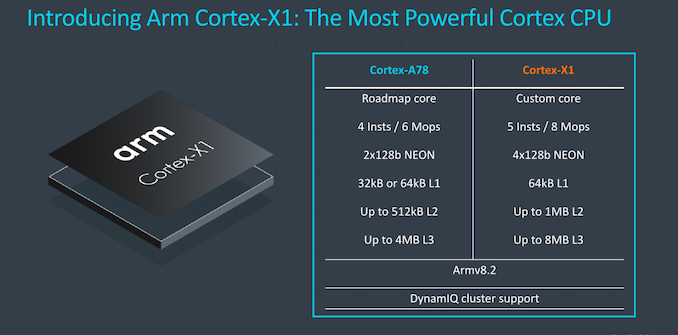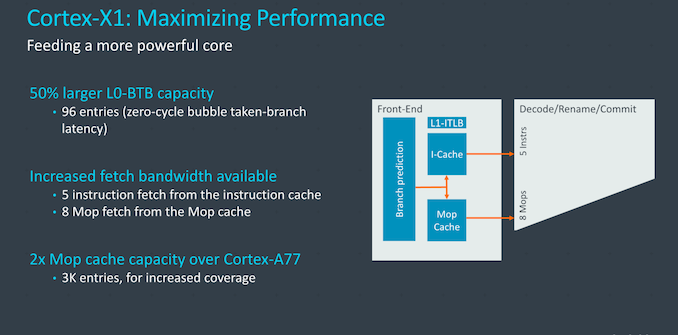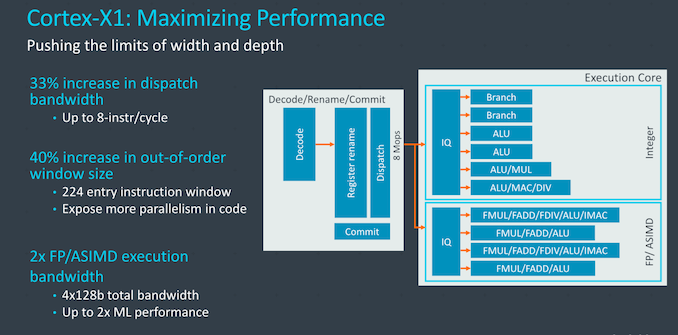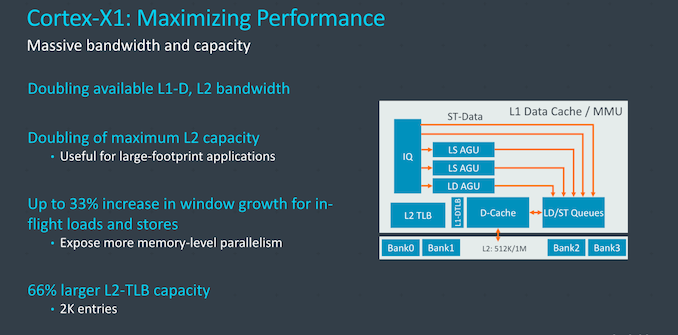Arm's New Cortex-A78 and Cortex-X1 Microarchitectures: An Efficiency and Performance Divergence
by Andrei Frumusanu on May 26, 2020 9:00 AM EST- Posted in
- SoCs
- CPUs
- Arm
- Smartphones
- Mobile
- GPUs
- Cortex
- Cortex A78
- Cortex X1
- Mali G78
The Cortex-X1 Micro-architecture: Bigger, Fatter, More Performance
While the Cortex-A78 seems relatively tame in its performance goals, today’s biggest announcement is the far more aggressive Cortex-X1. As already noted, Cortex-X1 is a significant departure from Arm's usual "balanced" design philosophy, with Arm designing a core that favors absolute performance, even if it comes at the cost of energy efficiency and space efficiency.
At a high level, the design could be summed up as being a ultra-charged A78 – maintaining the same functional principles, but increasing the structures of the core significantly in order to maximize performance.
Compared to an A78, it’s a wider core, going up from a 4- to a 5-wide decoder, increasing the renaming bandwidth to up to 8 Mops/cycle, and also vastly changing up some of the pipelines and caches, doubling up on the NEON unit, and double the L2 and L3 caches.
On the front-end (and valid the rest of the core as well), the Cortex-X1 adopts all the improvements that we’ve already covered on the Cortex-A78, including the new branch units. On top of the changes the A78 introduced, the X1 further grows some aspects of the blocks here. The L0 BTB has been upgraded from 64 entries on the Cortex-A77 and A78, to up to 96 entries on the X1, allowing for more zero latency taken branches. The branch target buffers are still of a two-tier hierarchy with the L0 and L2 BTBs, which Arm in previous disclosures referred to as the nanoBTB and mainBTB. The microBTB/L1 BTB was present in the A76 but had been subsequently discontinued.
The macro-op cache has been outright doubled from 1.5K entries to 3K entries, making this a big structure amongst the publicly disclosed microarchitectures out there, bigger than even Sunny Cove’s 2.25K entries, but shy of Zen2’s 4K entry structure - although we do have to make the disambiguation that Arm talks about macro-ops while Intel and AMD talk about micro-op caches.
The fetch bandwidth out of the L1I has been bumped up 25% from 4 to 5 instructions with a corresponding increase in the decoder bandwidth, and the fetch and rename bandwidth out of the Mop-cache has seen a 33% increase from 6 to 8 instructions per cycle. In effect, the core can act as a 8-wide machine as long as it’s hitting the Mop cache.
On the mid-core, Arm here again talks about increasing the dispatch bandwidth in terms of Mops or instructions per cycle, increasing it by 33% from 6 to 8 when comparing the X1 to the A78. In µops terms the core can handle up to 16 dispatches per cycle when cracking Mops fully into smaller µops, in that regard, representing a 60% increase compared to the 10µops/cycle the A77 was able to achieve.
The out-of-order window size has been increased from 160 to 224 entries, increasing the ability for the core to extract ILP. This had always been an aspect Arm had been hesitant to upgrade as they had mentioned that performance doesn’t scale nearly as linearly with the increased structure size, and it comes at a cost of power and area. The X1 here is able to make those compromises given that it doesn’t have to target an as wide range of vendor implementations.
On the execution side, we don’t see any changes on the part of the integer pipelines compared to the A78, however the floating point and NEON pipelines more significantly diverge from past microarchitectures, thanks to the doubling of the pipelines. Doubling here can actually be taken in the literal sense, as the two existing pipelines of the A77 and A78 are essentially copy-pasted again, and the two pairs of units are identical in their capabilities. That’s a quite huge improvement and increase in execution resources.
In effect, the Cortex-X1 is now a 4x128b SIMD machine, pretty much equal in vector execution width as some desktop cores such as Intel’s Sunny Cove or AMD’s Zen2. Though unlike those designs, Arm's current ISA doesn't allow for individual vectors to be larger than 128b, which is something to be addressed in a next generation core.
On the memory subsystem side, the Cortex-X1 also sees some significant changes – although the AGU setup is the same as that found on the Cortex-A78.
On the part of the L1D and L2 caches, Arm has created new designs that differ in their access bandwidth. The interfaces to the caches here aren’t wider, but rather what’s changed is the caches designs themselves, now implementing double the memory banks. What this solves is possible bank conflicts when doing multiple concurrent accesses to the caches, it’s something that we may have observed with odd “zig-zag” patterns in our memory tests of the Cortex-A76 cores a few years back, and still present in some variations of that µarch.
The L1I and L1D caches on the X1 are meant to be configured at 64KB. On the L2, because it’s a brand new design, Arm also took the opportunity to increase the maximum size of the cache which now doubles up to 1MB. Again, this actually isn’t the same 1MB L2 cache design that we first saw on the Neoverse-N1, but a new implementation. The access latency is 1 cycle better than the 11-cyle variant of the N1, achieving 10 cycles on the X1, regardless of the size of the cache.
The memory subsystem also increases the capability to support more loads and stores, increasing the window here by 33%, adding even more onto the MLP ability of the core. We have to note that this increase not merely refers to the store and load buffers but the whole system’s capabilities with tracking and servicing requests.
Finally, the L2 TLB has also seen a doubling in size compared to the A78 (66% increase vs A77) with 2K entries coverage, serving up to 8MB of memory at 4K pages, which makes for a good fit for the envisioned 8MB L3 cache for target X1 implementations.
The doubling of the L3 cache in the DSU doesn’t necessarily mean that it’s going to be a slower implementation, as the latency can be the same, but depending on partner implementations it can mean a few extra cycles of latency. Likely what this is referring to is likely the option for banking the L3 with separated power management. To date, I haven’t heard of any vendors using this feature of the DSU as most implementers such as Qualcomm have always had the 4MB L3 fully powered on all the time. It is possible that with a 8MB DSU that some vendors might look into power managing this better, for example it having being only partially powered on as long as only little cores are active.
Overall, what’s clear here about the Cortex-X1 microarchitecture is that it’s largely consisting of the same fundamental building blocks as that of the Cortex-A78, but only having bigger and more of the structures. It’s particularly with the front-end and the mid-core where the X1 really supersizes things compared to the A78, being a much wider microarchitecture at heart. The arguments about the low return on investment on some structures here just don’t apply on the X1, and Arm went for the biggest configurations that were feasible and reasonable, even if that grows the size of the core and increases power consumption.
I think the real only design constraints the company set themselves here is in terms of the frequency capabilities of the X1. It’s still a very short pipeline design with a 10-cycle branch mispredict penalty and a 13-stage deep frequency design, and this remains the same between the A78 and X1, with the latter’s bigger structures and wider design not handicapping the peak frequencies of the core.














192 Comments
View All Comments
Andrei Frumusanu - Thursday, May 28, 2020 - link
Again, I don't know what you're on about. The A12X has more GPU power and just as much bandwidth.ciderrules - Thursday, May 28, 2020 - link
I thought the A12X/Z had around 1.4-1.6 TFLOPS for GPU, and the SQ1 claims 2.0 TFLOPS? That would make the SQ1 slightly faster at GPU.jeremyshaw - Thursday, May 28, 2020 - link
What kind of TFLOPS? 32bit? 16bit? Ever hear the story of Vega the Wide? It had all of the TFLOPS, but just couldn't defeat the lower specced competition.ciderrules - Friday, May 29, 2020 - link
I’d like to know this as well. I’m giving the SQ1 the benefit of the doubt on this aspect, but as I stated above the A12X/Z is substantially more powerful on the CPU side. And it’s nearing 2 years old. Imagine what the A14X (if it releases this year) will do?iphonebestgamephone - Friday, May 29, 2020 - link
Those numbers dont always relate to performance.iphonebestgamephone - Friday, May 29, 2020 - link
No im basing on geekbench arm for windows benchmark, not the emulated one. Qualcomms tflops numbers dont show up in benchmarks either, the 855 had around 0.9 tflops according to qualcomm. The ipad pro scores 3x and more of 855 in gfxbench. Even using metal wont give that much of an advantage. Pretty sure an a12x is nowhere near 15w tdp.IUU - Thursday, June 11, 2020 - link
I am replying not only to you, but everyone who thinks, that since Apple or ARM can make so good cpus or gpus at 15 watts or x watts, ergo it is better than AMD or Intel or Nvidia that make chips on the 100 watts level. I am afraid this is not the case , and short answer is you can't beat physics. I will continue on a new reply. Just to let you know i am equally excited at what arm or apple achieved in the mobile space.IUU - Thursday, June 11, 2020 - link
Just because you are able to make a gpu run at 2 teraflops at 4 watts, this does not mean you can scale linearly to 300 watts. By that thinking , nvodia and amd should be making 300+ teraflops gpus, but they are incompetent , this is why they can't. At 7nm which only recently nvidia has begun to implement 20+ teraflops gpus are possible, theoretically combined with a multicore cpu , they make up a high end "power hungry" desktop or server. A top of the line phone costs between 500 to 2000 dollars. A not so top of the line desktop , costs hardly 5000 dollars, it consumes about 800 to 1000 watts and is about 10 times or more computationally capable compared to its mobile flagship competitor. On top of that most flagship desktop gpus are one or more nide processes behind , and despite this they maintain the above mentioned lead.So, there is no comparison, computationally speaking. At every price point, desktop implementations beat hands down , their mobile counterparts, not because they are somehow superior ,but because physics. If ARM or APPLE or whoever ever decide to scale to a bigger power envelope i bet you they are not going to be sigificantly better power/performance wise, because ...physics. Everyone who tries to promote either the mobile or the desktop sector as superior they do it because they are on an agenda.
If you want the best performance possible at the best price point go desktop.
If you want enough performance in a power limited scenario, go mobile,
But you will pay a premium for this. I don't disagree with paying a premium for this,
But I want to make clear I know what I get , and I know why I pay the price I pay for.
iphonebestgamephone - Monday, June 22, 2020 - link
Sure sir, anything new?Wilco1 - Wednesday, May 27, 2020 - link
Those are based on Cortex-A76. The X1 is > 50% faster, so will make even better laptops and tablets.